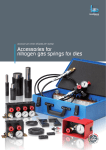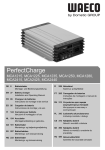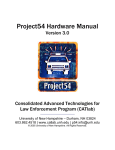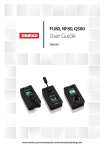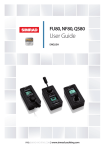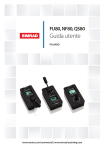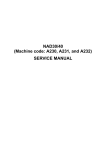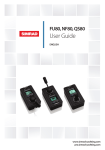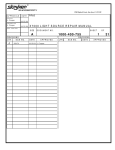Download MERIVAARA promerix O/R Table Service Manual
Transcript
MAINTENANCE MANUAL PromeriX operating table Type: Instructions Document: DO1085-2-2.en Complete: 13.3.2007 Version: 2-2 29.1.2009 1 WARNINGS, NOTES AND INSTRUCTIONS 5 2 GENERAL 10 3 4 2.1 Intended use 10 2.2 Operating characteristics 11 CLEANING 3.1 Cleaning instructions 12 3.2 Cleaning 12 3.3 Disinfection 12 3.4 Mattresses and pads 12 MAINTENANCE INSTRUCTIONS 4.1 Safety during maintenance procedures 13 13 4.1.2 Monthly service 13 4.1.3 Annual service 14 TECHNICAL DATA 5.1 Identification plate 5.1.1 Illustrated designations and symbols 14 18 18 18 5.2 Properties and materials 19 5.2.1 Surface materials 19 5.3 Specifications 6 13 4.1.1 Daily service 4.2 Troubleshooting and checklist 5 12 20 5.3.1 Environmental specifications 20 5.3.2 Electrical specifications 20 5.3.3 Classification data 20 5.3.4 Adjustment ranges 21 5.3.5 Weights and dimensions 21 MAIN COMPONENTS 22 6.1 Structure 22 6.2 Removal of casings 23 6.2.1 Table base casings 23 6.2.2 Column casing shrouds lifted up 23 7 6.2.3 Removing the column casings 24 6.2.4 Replacing castors 24 ELECTRONICS 7.1 Special user attention 25 7.1.1 Warnings 25 7.1.2 Block diagram 26 7.2 Battery 27 7.2.1 Replacing the battery 27 7.2.2 Battery charge 27 7.2.3 Storage of batteries 28 7.3 Power supply unit 28 7.3.1 Specifications 29 7.3.2 Replacing power supply 29 7.4 Mains fuses 30 7.5 Hand control units 31 7.5.1 Hand control unit MV-CUC01 31 7.5.2 IR-remote controller unit MV-CUI01 31 7.5.3 Device address programming 32 7.5.4 IR-remote control programming sequence 32 7.5.5 IR-receivers 33 7.6 Override panel MV-CUO 01 33 7.7 Foot switch 34 7.8 Level sensor 34 7.9 Inductive sensor 35 7.10 Wire sensors 35 7.11 Sensor connections 36 7.12 Motion Process Controller MV-MPC01 37 7.12.1 General 37 7.12.2 Communication 37 7.12.3 PC connection 37 7.12.4 Connectors 37 7.12.5 Cables 38 7.12.6 MPC connections 38 7.13 Solenoid pin connector configuration 8 25 HYDRAULICS 8.1 Safety information 39 40 40 8.1.1 Lift column 40 8.1.2 Warnings 40 8.2 Hydraulic unit 41 8.2.1 Removing the hydraulic unit 42 8.2.2 Hydraulic oil 42 8.3 Main valve block TLC3 8.3.1 Hydraulic circuit diagram 44 8.3.2 Substitution of TLC3 manifold 45 8.3.3 Exchange of TLC3 valve 47 8.3.4 Changing of solenoid coil at SP1 and TLC3 (valve system) 49 8.3.4.1 Remove the housing of the solenoid 8.4 Cylinders 49 50 8.4.1 Distribution block of table with sliding function 50 8.4.2 Distribution block of table without sliding function 51 8.4.3 Cylinder types 51 8.4.3.1 Leg and back section cylinder hose connections 51 8.4.3.2 Height cylinder connections 52 8.4.3.3 Trendelenburg cylinder connections 52 8.5 Floor lock cylinder type LF16 53 8.5.1 Connections 53 8.5.2 Cylinder type 53 8.5.2.1 Features 9 43 53 8.5.3 Floor lock support leg adjustments 54 8.5.4 Pressure switch and SP1 valve block 54 8.5.5 5th wheel cylinder block connection diagram 55 8.6 Seat section joint shields 56 8.6.1 Replacing joint shields 56 RECYCLING 57 9.1 Metals and plastics 57 9.2 Hydraulic cylinders and gas springs 57 9.3 Oil 57 9.4 Electronic waste and batteries 58 ORDER FORM 59 NOTES 60 Compiled by: Harri Uusitalo Approved by: Arto Koski-Laulaja _______________________________________ Date: ___ . ___ . _______ 1. WARNINGS, NOTES AND INSTRUCTIONS ! In order to ensure optimal surgical safety, all operating table users should carefully read the operating table and maintenance instructions before using the table. The entire surgical ward staff should be familiar with the correct use of the PROMERIX operating table as well as all warnings and observations concerning it. Warnings and observations found in this instruction manual are indicated as follows: ! ! WARNING! Please observe to ensure patient safety. CAUTION! Please observe in order to avoid causing damage to the equipment or its parts. NOTE! Please observe in order to improve operating table properties. WARNINGS! ! PromeriX operating table should only be used in facilities made for medical purposes. ! IP X4 classification is valid only when the mains cord is disconnected. ! Connect the mains cord only to earthed power supply. ! PromeriX shall be operated from it’s internal battery if the integrity of the protective earth conductor ! ! ! arrangement is in doubt. Place the patient in the longitudinal center line of the table top. In NORMAL mode max. patient weight with sliding seat section is 275 kg ( 600 lbs ). In NORMAL mode max. patient weight without sliding seat section is 325 kg ( 700 lbs ). In REVERSE mode max. patient weight is 180 kg ( 400 lbs ). ! Adjust the table top to the horizontal position ( 0-position ) with the hand control unit before transporting a ! Transporting of patients weighing up to 180 kg ( 400 lbs ) is only allowed when table top is in horizontal posi- patient on the operating table. tion ( 0-position ) and the height of the table is max 900 mm ( 3 ft ). 5 WARNINGS, NOTES AND INSTRUCTIONS ! ! ! Transporting of patients weighing 180-225 kg ( 400-500 lbs ) is only allowed when the table is in NORMAL mode, in horizontal position ( 0-position ) and in the lowest position. Transporting of patients weighing 225-325 kg ( 500-700 lbs ) is not allowed. ! Use extreme caution when transporting the table with a patient on. Transporting of the table with a patient on ! To avoid endangering the patient's respiratory system, nerve pathways and circulatory system, the patient ! Check that table top sections catches lock correctly. Incorrect attachment of table sections is dangerous and ! ! requires two persons. To maximize patient safety utilize proper restraint methods during transport. should be positioned properly and kept under observation! can cause personal injury or equipment damage! Use only accessories recommended by the table manufacturer. When adjusting the operating table, take care to avoid collision between accessories and the operatingtable. ! Do not use worn or damaged accessories. When using the table, ensure that all accessories are properly ! When adjusting the operating table, take care that the fingers, hands or other parts of the body of the patient mounted and check the function of accessory locking and adjustments. are not placed between edges of back, leg or seat section frames and pivoting points. ! Use only permitted table top configurations illustrated in this manual. ! Ensure before adjusting the operating table that table top will not hit external obstacles. ! ! Ensure before adjusting the operating table that NORMAL/REVERSE mode has been chosen correctly and is the same as patient's orientation on the table top. After use of main switch NORMAL mode is set as default. Always follow manufacturer instructions when using diathermy or defibrillation equipment. When using high frequency surgical equipment take care to prevent the patient coming into contact with ! metal parts of the operating table or accessories. Do not place the patient on wet or damp surfaces or electri- ! Combustible anaesthetic gases must not be used with the Promerix operating table. cally conductive pads. Hazard of burn injuries! 6 WARNINGS, NOTES AND INSTRUCTIONS ! ! Use potential equalization conductor with patient monitoring equipment. Connector placed at the table base. ! When recharging the battery first plug the mains cord to table appliance inlet, after that to wall socket. Main switch can be used as an emergency stopping device ( demanded by the standards ). Normally the ! switch lever is in up position. When the lever is turned down in OFF position all table functions are cancelled. ! When recharging is completed disconnect the mains cord first from the wall socket, after that from the table ! ! Table movement stops immediately. appliance inlet. Disconnect the mains cord from the table and turn the main switch to OFF position before cleaning of the table. Disconnect the mains cord from the table before any service procedures. 100-240 V ~ used in power unit placed in table base. Hazard of electric shock! Promerix operating table has been tested to EN 60601-1-2 to ensure proper electromagnetic compatibility. ! Other products used in the vicinity of Promerix operating table should also comply with this standard. If they do not comply, interference between products in unintended responses may occur. Please contact the appropriate manufacturer if any problems arise. ! Portable and mobile RF-communications equipment can affect Promerix operating table. 7 WARNINGS, NOTES AND INSTRUCTIONS ! CAUTIONS! ! ! ! ! ! ! ! ! ! ! ! ! ! If the operating table has been in the cold, allow it to warm up at room temperature for at least 6 hours before recharging the battery or switching on, to allow any condensation formed to evaporate. Recharge the battery prior to use. See the starting instructions attached to table base panel. OVERRIDE panel is only for returning the table top to the horizontal position in the case of electronic malfunction. Override makes it possible to adjust table without the controlling processor and any of the programmed restrictions are not functioning. Downwards adjusted leg or back section may hit the table base or column casings depending on the used height or tilt angle adjustments. Can cause damage to the operating table and creating pinching hazard! Do not place any objects on the base of the operating table! Danger of damage during adjustments! The best place to store the hand control unit especially during transport is the lever under the head section. Head and devided leg section 60475 gas springs can be disposed of as metal waste after nitrogen gas and oil has been removed. Instructions for gas releasing available from your sales representative. Operating table has been classified as splash proof equipment. Use of pressurized water is not allowed. Cleaning and disinfecting should be made according to this manual. Do not pull or push the shields of back and leg section joints. Check during adjustment that there is no foreign obstacles between shields. It is possible to adjust the SLIDE adjustment only when back or leg section are in horizontal or above horizontal position. Slide adjustment will stop automatically before collision if back or leg section in under the horizontal position. SLIDE adjustment is only possible when table top is in horizontal position. Use of SLIDE adjustment is restricted with tilted table top. Mattresses should be cleaned only with neutral detergent ( ph 7-8 ). The antistatic properties of the operating table require the use of original brand mattresses and antistatic flooring. 8 WARNINGS, NOTES AND INSTRUCTIONS ! NOTES! It’s recommended to recharge the battery overnight after day’s use. Table will be always ready for use and the battery will have longer service life. If the main switch is turned to OFF position ( downwards ), all table functions are blocked including recharging of the battery. Check that the green led above the charging inlet lights up when you connect the mains cord to the table. When mains cord is connected to operating table the cooling fan of the power unit is activated causing a humming sound. After disconnecting the mains cord the cooling fan still runs for few seconds. Turn the main switch to OFF position ( downwards ) when the table is not in use or stored for longer period of time. This eliminates the possibility of unintended use and is also saving the battery capacity. Activate the floor lock before adjusting the table. Only trendelenburg and back rest adjustments are functioning if floor lock is not activated. Cardboard packing material should be recycled. Wood and plastics are energy waste. Batteries contain lead and if replaced, need to be recycled in accordance with local environmental regulations. Velcro tapes on table top plates can be cleaned with pressurized air. Velcro tape can also be replaced; spare parts and instructions available from Merivaara service dpt. Floor lock can be deactivated with a release knob placed at the table base if normal deactivating with hand control unit or override panel can’t be done. Turn the knob 90° clockwise and the table will descend on to its castors. Turn the knob back to its original position after releasing. 9 2. GENERAL Merivaara Corporation conforms to all its operations ISO 9001 Quality Management and ISO 14001 Environmental Management System Standards. In addition the Promerix operating table meets the following standards: EN 60601-2-46, EN 60601-1-2 ( EMC ) and EN 60601-1. The table complies with directive 93/42/EEC ( MDD ) product class I, and bears a CE marking based on this classification. 2.1 Intended use Promerix Operating Table is intended for general surgical use. It is also well suited for: • Day surgery • ENT surgery • Plastic surgery • Orthopedics • Arthroscopy • Gynecology • Urology • Pediatrics • Neurosurgery Expertise is essential The patient is the most important part of treatment. This is precisely why the equipment used in treatment must be absolutely safe and convenient to use. As a health care professional, you deserve the very best tools, allowing you to concentrate on your own field of expertise. Merivaara is an expert in providing hospital equipment. Merivaara products have been designed to function efficiently and flexibly during the various stages of treatment. They assist you in the performance of your work, without distracting you from the task at hand. Our modular equipment system includes state-of-the-art equipment for hospital procedures and hospital room environments as well as for nursing homes and home care applications. For more information on Merivaara products, contact our Sales Office. For matters related to equipment servicing, contact the Merivaara Service Department. 10 2.2 Operating characteristics Promerix is transportable electrohydraulic battery and mains operated operating table. It is microprocessor controlled and it‘s function parameters are reprogrammable with special PC-operated service program. Table can be connected to 100….240 VAC mains power and its secondary voltage is 24 VDC. The table electronics are safely earthed and it has equipotential connection. Table top consists of fixed or sliding seat section and detachable 25 and 40-sections. You can rearrange the sections as you wish depending on the surgical concept and operation. Look page 14. The width of the table top is 540 mm, ( 21 1/4 inch ) without rails and length 2100 mm ( 82 inch ). Table top plates are x-ray translucent material. Promerix can be adjusted with cable connected hand control unit, IR-hand control unit or foot switch. Operating table can also be adjusted with override panel in case of electronical malfunction ( hand control unit or table microprocessor defective ). Safe and fault-free use and maintenance of the equipment requires careful acquainting to these instructions. When mounting accessories to the equipment, the instructions provided with them must be followed closely. Always keep the instructions for accessories together with this manual. 11 3. CLEANING 3.1 Cleaning instructions ! ! ! ! Disconnect the mains cord from the table and turn the main switch to OFF position before cleaning of the table. Operating table has been classified as a splash proof equipment. Use of pressurized water is not allowed. Cleaning and disinfecting should be made according to this manual. Do not pull or push the shields of back- and leg section joints. Check during adjustment that there is no foreign obstacles between the shields. Surface of the Promerix mattresses is electrically conductive. Cleaning of the mattresses should be done with neutral detergent( pH 7-8 ) and warm water applied with a single use wipe. 3.2 Cleaning • Remove accessories and mattresses. • Clean by wiping down with a mild alkaline detergent ( pH 7-8 ). 3.3 Disinfection • Remove accessories and mattresses. • Disinfect only when necessary. • Wipe down the equipment with the surface disinfectant used at the facility in accordance with manufacturer instructions, unless the surface disinfectant contains phenols and alcohol, which can corrode plastic parts and mattresses. ! ! NOTE! Dry the operating table carefully immediately after cleaning or disinfecting. 3.4 Mattresses and pads Read the care instructions for mattresses and pads. 12 4. MAINTENANCE INSTRUCTIONS 4.1 Safety during maintenance procedures ! Maintenance allowed only to persons specialized to Promerix service work. ! Disconnect the mains cord from the table before any service procedures. 100-240 V ~ is used power unit ! Turn the main switch to OFF position before connecting or disconnecting any of electronic connections or ! Static charges can cause sparks harming sensitive electronic components. Ground yourself to metallic parts ! placed in table base. Hazard of electric shock! components in order to protect them against voltage surges. of table before touching electronic components. Disconnecting any of the hydraulic hoses can cause uncontrolled and dangerous movement of the table. Support the table parts before disconnecting any hydraulic hoses! When mains cord is connected to operating table the cooling fan of the power unit is activated causing a humming sound. After disconnecting the mains cord the cooling fan still runs for few seconds. 4.1.1 Daily service • During normal cleaning, check-up general condition of the operating table. Contact service personnel if needed. • We recommend that you charge the table battery every day. This is to ensure sufficient battery charge level and long service life. • Check the mains cord condition. • Promerix operating table must be cleaned carefully after each surgical procedure! 4.1.2 Monthly service • Clean and lubricate guide pins, latches, spring-loaded pins and pivoting points with light machine oil or spray vaceline. • Check that castors roll smoothly and floor lock is functioning correctly. • Test table functions by adjusting them to their extreme positions. 13 • Check hand control unit and foot switch cables, connector and plug. 4.1.3 Annual service • Perform all daily and monthly service actions. • Check the functioning of table section's latches. • Check all cables and connectors, regarding injuries (kinks, cracks, wear) • Visual check at the hydraulic hose connections and piston rods, regarding external leakage. • Check of the oil level in the reservoir of the oil pump, if the level is too low fill up with filtrated mineral oil (ARAL VITAM DE32). • ! Oil change: every 5 years All electrical repairs must be performed by a licensed electrician. 4.2 Troubleshooting and checklist POSSIBLE SITUATIONS: PROBLEM: Table will not activate when pressing ON/OFF-button PROCEDURE: CAUSE: -Main Switch in OFF position Turn to ON position -Hand Control Unit not connected properly Check the connection -Faulty Hand Control Unit Replace the hand control unit -Broken Hand Control Unit cable Replace the cable -Empty batteries Connect mains cable and recharge batteries -Battery fuse blown Check and replace -Faulty MPC Replace MPC 14 ! PROBLEM: Table adjustment not functioning when pressing function button, table activated PROCEDURE: CAUSE: -Floor lock not activated Press activation button -Making adjustment table program restricts Check the table positioning -Adjustment already in its end position Check the table positioning -Faulty hand control unit or IR-control unit not programmed correctly. Check the control unit PROBLEM: Table movement won’t stop although function button is released PROCEDURE: CAUSE: -Severe functioning failure of electronics. Malfunctions are always recorded in the Error Log. MAIN SWITCH to OFF position! Use service program manual to resolve error code. -Faulty hand control unit MAIN SWITCH to OFF position! Contact service -Valve is mechanically stuck or stays open constantly Contact service, new valveblock or solenoid is needed -Short circuit in the transistor controlling the solenoid Contact service -Damaged solenoid or sensor wires Contact service PROBLEM: Back section moves when leg section button is pressed or vice versa PROCEDURE: CAUSE: -Normal/Reverse – mode wrongly selected Check the selected mode ! PROBLEM: Audial signal when using IR-hand control unit PROCEDURE: CAUSE: - Indicates that the operating table floor lock is not activated! Press the floor lock button steadily! - Cause no marking into the Error Log Reset by pressing the ON/OFF button. 15 PROBLEM: Table not responding to IR-hand control unit commands PROCEDURE: CAUSE: -Control unit wrongly aimed Aim towards the table -Distance between table and control Check the distance -IR-receiver blocked Check -IR-control unit battery depleted Replace batteries -IR-control unit wrongly coded Set codes again ! -Emergency situations use override panel buttons! PROBLEM: Table motion stops during adjustment PROCEDURE: CAUSE: - A simultaneous commands will stop the table movement Release another of the pressed buttons - Can cause if foot control and hand control units are pressed at the same time. Use one control unit at the time PROBLEM: One piece leg section can not be adjusted PROCEDURE: CAUSE: -One piece leg sections not attached to seat section correctly Check the latches -Faulty inductive sensor Contact service PROBLEM: Hydraulic unit starts but no movement occurs PROCEDURE: CAUSE: -Valve block solenoid defective or loose Contact service -Table adjustment in its end position Check the table positioning The table changes position by itself PROCEDURE: - Control unit buttons are accidentally pressed or pinched Check the control unit PROBLEM: 16 CONTACT: Further information of PromeriX service, product support and spare parts are available from your local dealer or from Merivaara Corp. Merivaara service +358 3 3394 6152 Merivaara service fax +358 3 3394 6249 E-mail [email protected] Internet www.merivaara.com 17 5. TECHNICAL DATA 5.1 Identification plate Identification plate is located in the joint, under of the seat section. Consult accompanying documents Primary voltage and frequency Manufacturing date Ingress Protection Splash proof Safe max. working load CE approved device B-type applied part ID-plate 5.1.1 Illustrated designations and symbols Equipotentiality Protective grounding ~ Alternating current B-type applied part ! Attention, consult accompanying documents 275 kg =180 Maximum load with slide ( including patient, mattresses and accessories ) 325 kg =180 Maximum load without slide ( including patient, mattresses and accessories ) 18 5.2 Properties and materials 5.2.1 Surface materials Surface materials used in Promerix table with possibility to skin contact: Epoxy coated steel Frame constructions Zinc plated steel Frame constructions Stainless steel Accessory rails, casings, frame constructions Aluminium bronze Pivots High pressure laminate Table top plates PUR Mattresses Anodized aluminium Table top section sides Polycarbonate ( PC ) Hand control unit B-cover and battery cover Silicon Hand control unit A-cover EPDM-rubber Bellows ABS+PMMA Base and castor covers PC/ABS-composite Override panel ABS IR-receivers 19 5.3 Specifications 5.3.1 Environmental specifications Promerix is designed to be used in following environmental conditions: Ambient temperature +10 ... +40 °C Ambient pressure 700 ... 1060 mbar Relative humidity 30 % ... 75 % Transport temperature - 10 ... +40 °C Storage temperature +10 ... +40 °C 5.3.2 ! Electrical specifications Primary voltage 100 - 240 V~ Frequency 47 - 63 Hz Secondary voltage Nom. 24V DC Maintenance free sealed lead acid battery 24V / 18 Ah Max. power consumption 600 W Main fuses F10A ( 5x20 2 pcs ) Normal recharging time 5 - 10 h ( depending on battery charge level ) Operation time with full battery approx. 180 min. Max. uninterrupted operating time 2 min / 10 min ( ED 20 % ) If you would like more detailed information, please contact the Merivaara service department. 5.3.3 Classification data Promerix is classified according to EN 60601-1 as follows: Electric shock protection Class I equipment, internally powered Degree of electric protection B-type Protection against liquids IP X4 / Splash proof equipment Cleaning and disinfecting According to instructions, on page 13 Operating Rate Intermittent operation / ED 20% Protection against flammable anaesthetic gases Do not use with combustible gases Safe working load 325 / 275 / 225 / 180 kg incl. patient, mattresses and accessories. 20 5.3.4 Adjustment ranges WITH SLIDE WITHOUT SLIDE Height 650 - 1110 mm 610 - 1070 mm Longitudinal shift 410 mm Lateral tilt ± 25° Back section - 45° ... +80° - 45° ... +80° ( +4° / -1°...+1° / -4° ) Leg section - 105° ... +70° - 95° ... +70° ( +4° / -1°...+1° / -4° ) Trendelenburg and antitrendelenburg ± 35 Headrest ( Std. ) - 45° ... +45° 5.3.5 - ( 0 / +10 mm ...+/ -5 mm ) ( 0 / -10 mm ) + 20° ( ±2,5 ° ) ± 35 ( ±2,5 ° ) - 45° ... +45° ( 0 / +5 °...0 / -5 ° ) Weights and dimensions WITH SLIDING FUNCTION WITHOUT SLIDING FUNCTION Table top 6-sections 6-sections Weight of table 325 kg 300 kg Length (A) 2100 mm 2100 mm Width (B) 610 mm 610 mm Height (C) 650 - 1110 mm 610 - 1070 mm Lenght of the base (D) 1200 mm 1200 mm Table top width without rails (E) 540 mm 540 mm Table top width with rails (F) 594 mm 594 mm Floor clearance (G) 25 mm ( 0 / + 3 mm ) 25 mm ( 0 / + 3 mm ) Castors Ø 125 mm 125 mm Longitudinal Shift 410 mm - Castors distance (H) 1100 mm 1100 mm Dimensional drawing A F E 250 500 400 400 250 G C 301 H D B 21 6. MAIN COMPONENTS 6.1 Structure 25-section 40 gyn-section Seat and sliding section Distribution block Back section 25-section Head section Back and leg section cylinders Casing shroud Override panel Lifting column Floor lock valve block Hydraulic unit Power supply Battery Main valve block MPC Cylinder for Trendelenburg Castor Base frame Main switch, fuses and charging socket CONTROL DEVICES: IR-remote control Foot control 22 Hand control unit 6.2 Removal of casings 6.2.1 Table base casings 5 4 3 1 2 ! Disconnect the mains cord from the table and turn the main switch to OFF position before removing any casings! • Remove screws from the lowest protective casing shroud ( 1 ) 4 pcs. • Remove plastic head screws from both sides of the base casings ( 2 ) 4 pcs. • Lift the lowest casing shroud ( 3 ) slightly up and pull the Rear base casing cover ( 4 ), Front casing cover ( 5 ) away from the end of the table. • 6.2.2 Assemble the casing in reverse order. Column casing shrouds lifted up 2 1 • Check that the table is its highest position, for better access. 23 • Lift the casings (2) up, within each other and hang under the seat section of the table top or support with suitable braces. ! You don‘t have to remove casings completely in all situations. Assemble the casing in reverse order. ! 6.2.3 Removing the column casings If you need to remove column casings completely, e.g. changing sensors, disassemble shrouds one by one. • Starting on lowest casing shroud. • Look at the section 6.2.1. Remove screws (1) 4 pcs which are fixing the lowest column casing shroud to the base. • Remove the shroud piece fixing screws 4 pcs with 2 mm Allen wrench. You may need to push shroud pieces slightly inwards because of shroud sliding brackets. 6.2.4 ! Replacing castors Before you get access to remove castors you have to use ramp or lift up the operating table from the ground. One bearing is installed top of the frame and another in the base of the castors shaft. Castors are fixed with M6 bolts. Removing with 5 mm Allen wrench. - 1 pcs fixing bolt Fixing bolt - 1 pcs washer - 1 pcs plastic washer Washers - 2 ball bearings, lubricated for life 24 7. ELECTRONICS 7.1 Special user attention To assure the highest degree of operating safety all the users of the operating table should carefully familiarize themselves with the instructions for use and maintenance manual before use of this table. Aquainting your operating personnel to only proper use of the Promerix operating table and also to the warnings, cautions and notes relating to it. 7.1.1 ! ! Warnings When adjusting the table take care that the fingers, hands and other parts of the body of the patient are not placed between edges of back / foot or seat section frames and pivoting points. Disconnect the mains cord from the table and turn the main switch to OFF position before touching or removing any electronic components! ! Ensure to full, appropriate functioning after repairing, connections must be performed with using approved ! Installation must be done according to local regulations and standards. If any doubt, consult a licensed tech- components. nician. 25 86% 7LOW6OLGHRU%DFN 26 390 152 /HG 088726 LQ9 RXWQRP9 3RZHU&KDUJHU (0,)LOWHU %DWWHU\ 9$K ,55HFHLYHUV 7(.,-b -86825$- 0DLQVZLWFK 7UHQG 7LOW /HYHOVHQVRU 86% +HLJKW $SSOLDQFHLQOHW )XVHV 2YHUULGH 6,'1( +<9b.6 %DFN /HJ5,QGVHQVRU +HLJKW %/2&.',$*5$0 (/+<'&20321(176 3520(5,; 3,17$.b6,77(/< /$678$0,1(1,62P. +,76$7875$.(17((7(1,62%( 1,0,7<6 0$7(5,$$/, .3/ 9$ 9$ 9$ 0 9$ 6OLGH 72/(52,0$7720,(10,772-(1 7<g7$3$.2+7$,6(772/(5$166,7 26$152 1,0,.(781186 0RWRURXWSXWV 03& %DFN 7LOW 2SWLRQ 0 0 0 RSWLRQ RSWLRQ 6OLGHPRWRU +<9b.6 3,,57b1<7 -86825$- $ 0,77$.$$9$ 0$66$.* 3,17$$/$'0 78/267(778 .*26$ 9DOYHEORFN WK:KHHO )ORRU/RFN +\GUDXOLFXQLWPRWRU 7UHQG 1,0,7<6 9$ /HJ5 )ORRU/RFN 6DIHW\HGJHV 2SWLRQGLJL +HLJKW 3UHVVXUHVZLWFK 6DIHW\HGJH :LUHDQG,QGVHQVRUV /HJ/,QGVHQVRU /RJLFLQSXWV )RRWVZLWFK 7UHQG 2SWLRQDQD +DQGSDQHO6LGQH 3RZHULQSXW /HJ/ 2YHUULGH,5 )RRWVZLWFK /HJ5 6ROHQRLGRXWSXW ,5+DQGSDQHO WKZKHHO /HJ/ +DQGSDQHO 6DIHW\HGJH 7.1.2 Block diagram 7.2 Battery Two 12 V batteries connected in series. Nominal Voltage 2 x 12 V Nominal Capacity 18 Ah Dimensions (LxWxH, mm) 181 x 76 x 167 Approximate weight 6.2 Kg Internal Resistance (Fully charged battery) 10.5 mΩ Maximum charging current 4.5 A Terminals Bolt and Nut M5 Torques 4.5 Nm Storage temperature -20°C to 40°C Operative temperature range Charge__________________0° C to 40°C Discharge_______________-20°C to 50°C Case material 7.2.1 Acrylonitrile-Butadiene-Styrene Replacing the battery 4 5 • tion. • 6 Turn the operating table main switch to OFF-posiRemove the front casings of the table base, check section 6.2.1 at the page 23 . 7 8 6 • Unplug the electric conductor (1) • Remove the screw (2) holding the battery frame (outside of the base) look at the page view A. 1 look at the page 29 view A. Remove the screws (4) 7 and cover (5) 2 3 • Disconnect the wire sets (6) CODES: - Bettery assembly - Battery - Fuse 7.2.2 Battery charge • Voltage measurement • Current limitation and measurement • Constant voltage charging 27,8 V 27 A31596800 7133593 (7) 71342542 (8) LED indication for battery and charge state - Green LED = Battery OK - Yellow LED = Lowered battery capacity - Flashing yellow LED = Not fully charged - Flashing green LED = Fully charged battery (charge current is less than 150 mA which means - > 80 % of total capacity, still charging). - Red LED = Battery empty, connect to powerline Charging continues all the time when power is connect to line. Indication level parameters can be changed with PC Service Program. 7.2.3 Storage of batteries Batteries should be storaged in a dry, clean condition and charged before storing. At a storage temperature of 20° C, batteries should be re-charged after 8 months. At higher temperature, re-charging should take place more frequently. Discharged batteries should be re-charged within one week. ! WARNING ! Do not open the vents. Replace always both batteries together. Use only the batteries delivered or recommended by the manufacturer. Notice local disposal regulations. 7.3 Power supply unit Medical rated Power supply code: A41788100 without fixing bracket Secondary voltage set screw 2 Secondary voltage set screw 1 Base fixing bolt Line Unit fixing bolt 28 Ground Neutral 7.3.1 Specifications 100 - 240 V ~ Input voltage, alternating current 47 - 63 Hz Frequency 27,8 Output voltage, direct current 115 °C Overtemperature protection, measured internally 600W Output power Output overvoltage protection 110-140 % V nominal CE\UL\CSA approved device. 7.3.2 Replacing power supply ! All electrical repairs must be performed by a licensed electrician. ! Disconnect the mains cord from the table before any procedures. ! Cases when you have to replace power supply unit, read well all the warnings, specifications and notations. ! Work only when the table is de-energized state. ! ! Check and mark all cable connections before removing. Use professional, protected tools. 29 - Power supply is fixed with two bolts which you can screw out with 5 mm Allen wrench. Fixing bolt '(7$,/% 6&$/( Power supply $ '(7$,/$ 6&$/( Holding the battery frame % 7.4 Mains fuses ! Mains receptacle includes 2 x F10A fuses, which can be easily changed. Turn the main switch OFF before continuing. 2 pcs 5X20 fuses Code: 71342751 Push-in fuses Fuse box Appliance inlet Push the sealing plug side clips simulta- PUSH neously and pull the plug cover out from PUSH the receptacle! Sealing plug 30 7.5 Hand control units 7.5.1 Hand control unit MV-CUC01 FEATURES: - LED indications; Orient, Floor Lock, 5th Direction Wheel - Battery state (green, yellow, red) - RS232 serial communication with MPC - Key Matrix 4x7 =28 - IP-54 - Backlight Boost converter REPLACEMENT PARTS: - Cable is equipped with quick connector which can easily connect to the PCB - Battery cover module with cable installed, CODE A41809700 - A-silicone cover, CODE A21560600 - B-cover CODE A41809600 - Hook CODE A41829300 7.5.2 IR-remote controller unit MV-CUI01 FEATURES: - Same PCB as in hand panel but with different components - Micro chip PIC16LF874A - Crystal 4 MHz A-silicone cover - IR-transmission - Key matrix 4 x 7 Suspension hook - IP 54 -Backlight boost converter B-cover housing Battery cover 31 LED INDICATION: - Battery state green/red REPLACEMENT PARTS: - A-silicone cover, CODE A41811100 - B-cover housing, CODE A41809600 - Battery cover, CODE A31638600 - Suspension hook, CODE A41829300 - AA-batteries 4 pcs, CODE 71335974 7.5.3 Device address programming An device address is saved in the non-volatile EEPROM memory of each table during final testing. The only table movement commands that the table‘s microcontroller accepts are IR-messages, which are send via this address. The table addresses can be programmed remote controls memory following the instruction sequense shown below. 7.5.4 IR-remote control programming sequence Device instructions uses double button press functions, which are not used during normal operatio. This is designed to prevent accidental activation of the address selection sequence. The address search/instruction process goes as follows: 1. Point the remote control at the operating table. 2. Press the backlight button while pressing the buttons on the right side of the remote control one after the other from bottom to top. 3. When the operating table buzzer gives two consecutive tones, the correct address group has been found. 4. Keep the backlight button pressed down. 5. While holding the backlight button press the buttons for rows found in above section 3 on the left side of the remote control. 32 6. Keep the buttons pressed down untill the operating table buzzer begins to send short, rapidly repeating tones. The tones will sound in 2 seconds, during which time the buttons on the left should be released. If the buttons are held down the tone will sound in 16 second intervals. 7. Release the backlight button. The operating table buzzer will then give a long tone. The table‘s individualised device address is now saved in the remote controls memory. 8. The operating tables mechanical movements can be controlled with this remote control after the instruction sequence. The saved device address is maintained in the remote controls non-volatile memory, even when changing the batteries. 7.5.5 IR-receivers - Infra-red transparent ABS-cover - 2 pcs - Fixing bolts inside the column shrouds - Protected with polyurethane tape -CODE A41617700 7.6 Override panel MV-CUO 01 FEATURES: - Key(s) with simultaneous multiple inhibition 1 - LED Indications; Orient, Floor Lock, 5th Wheel, Battery state (green, yellow,red) - Buzzer oscillation circuit - IR-receiver inputs 4 - Key panel (1) 3 2 - protective plug (2) - Fixing nut (3) CODE A41713500 with cables (fixing parts not included) CABLE INTERFACES: - USB for PC service software - RS-232 for hand control (LEMO) - Foot control connection (LEMO) - Control/monitoring system connection (LEMO) 33 - Washer (4) 7.7 Foot switch • 6 digital inputs with common ground. • Programmable • LEMO connector • Foot control, CODE 60850 7.8 Level sensor NRO PVM MUUTOS 2 03.12.2007 Johtojen määrä ja väri muuttunut TEKIJÄ HYVÄKS. JUSUORAJ 38 41 13,5 2 4, Kaapelin pituus 1500 mm 2 Wire color Name White Brown Green Yellow GND Vcc Output X Output Y Function Ground Power supply X-axis output Y-axis output Supply voltage: 5 +/- 0,25 V Range: +/- 90 ° Weight: ~60 g Protection: IP 66 Kiinnitys yläkiinnityskehään: - 70611 M4x6 DIN 7984 - 2 kpl OSA NRO NIMIKETUNNUS NIMITYS 1 NIMITYS 2 TOLEROIMATTOMIEN MITTOJEN TYÖTAPAKOHTAISET TOLERANSSIT: MATERIAALI MITTAKAAVA MASSA KG PINTA-ALA DM2 TULOSTETTU LASTUAMINEN: ISO 2768-mK HITSATUT RAKENTEET: EN ISO 13920-BE PINTAKÄSITTELY KPL 1:1 KG/OSA 0.12 PIIRTÄNYT 0.01 18.1.2008 28.06.2005 JUSUORAJ HYVÄKS. NRO PVM MUUTOS TEKIJÄ HYVÄKS. KULMA-ANTURI VTI SCA121T-D09 PROMERIX A7134361-2 CODE A7134361 ! NOTE! After replacing level sensor reprogramming with service program is needed. Consult Merivaara service department. 34 7.9 Inductive sensor Sensor nominal voltage 24 V Current type DC Wiring 3-Wire Switching function type NO Output signal PNP Rated operational Voltage 24 V DC Rated operational current 200 mA Supply voltage 10...30 DC Inductive sensor, type PNP 1 4 2 3 Sensor CODE A42108700 Spare part set CODE A31631500 - Sensor (1) is mounted inside leg section joints. Cable WIRE CONNECTIONS: is protected with protective mesh. - Black, signal - Sensor is fixed with locking screw (2) and plastic bushing (3) - Blue, GND - Cable is locked with locking screw (4) and wires are connected with wire end ferrules to terminal block, look at page 36. - Brown, +24 V - After installation, adjustment ranges must be tested 7.10 Wire sensors - 0...5 V analog output SENSOR CONNECTIONS: 1. +5 V, brown 3 2. Signal wire, white 1 3. GND, green 2 - Height, WPS-500, CODE 7134362 - Slide, WPS-250, CODE 7134363 - Back section, WPS-150, CODE 7134364 - Leg section, WPS-150, CODE 7134364, 2 pcs 35 36 24.10.2008 PVM NRO Sensor type Slide Back Height Leg left Leg right Leg left Leg right 5th wheel Floor Lock Safety edge Safety edge Ind sensor Ind sensor Wire sensors Wire sensor Wire sensor Ind sensors Wire and Ind sensors Wire sensor Wire sensor Wire sensor Pressure switch Pressure switch Leg side Back side VTI-sensor VTI- sensor Tilt (Y) VTI-sensor Trend ( X) VTI-sensor Pressure switches/safety edges Name MUUTOS Numbering starting from bottom as it is in the tables Signal Signal +5V Signal Signal +24 V GND Signal Signal Signal +5 V GND Signal Signal +24 V GND Signal Signal Signal Signal Function 5 White L White R Pink Grey L Grey R Brown Green/Blue White Yellow White Brown White Yellow Green Red Green Black Black Black Black 20 19 18 17 16 15 14 13 12 11 10 9 8 7 6 5 4 3 2 1 Colour No Wires from sensors TEKIJÄ JUSUORAJ HYVÄKS. Colour 7134341 Slide Back Height Leg left Leg right Leg left Leg right ANTURIEN LIITTIMET SENSOR CONNECTORS PROMERIX PINTAKÄSITTELY LASTUAMINEN: ISO 2768-mK HITSATUT RAKENTEET: EN ISO 13920-BE NIMITYS 1 LIITIN MSTBHK 2,5/10-G 5.08 HYVÄKS. PIIRTÄNYT 29.07.2005 JUSUORAJ A31605000-5 1:1 KG/OSA 0.1 0.1 MITTAKAAVA MASSA KG PINTA-ALA DM2 TULOSTETTU 15.12.2008 0.32 0.25 NIMITYS 2 PHOENIX CONNECTOR PHOENIX CONNECTOR Ind sensor Ind sensor Wire sensors Wire sensor Wire sensor Ind sensors Wire and Ind sensors Wire sensor Wire sensor Wire sensor 5th Wheel Pressure switch Floor Lock Pressure switch Safety edge Leg side Safety edge Back side VTI- sensor VTI- sensor Tilt ( Y) Trend (X) Pressure switch/safety edges Name LIITIN PISTOKE MSTB 2,5/10-ST 5.08 MATERIAALI KPL 2 2 Signal Signal +5V Signal Signal +24 V GND Signal Signal Signal +5 V GND Signal Signal +24 V GND Signal Signal Signal Signal Function TOLEROIMATTOMIEN MITTOJEN TYÖTAPAKOHTAISET TOLERANSSIT: OSA NRO NIMIKETUNNUS 7134342 1 Yellow/brown White/Yellow White Pink Blue White/black Yellow Black Grey Red Brown Green Lila Grey/pink Brown/Black Black Grey/brown White/grey White/pink Pink/brown 2 10 9 8 7 6 5 4 3 2 1 20 19 18 17 16 15 14 13 12 11 No Wires from MPC/D-connector 7.11 Sensor connections 7.12 Motion Process Controller MV-MPC01 7.12.1 General The MPC is installed on the surface of the outer tube of the column guiding system. CODE A41744800 - PC-programmable icrocontroller, PIC18F4550, Quartz crystal 12 MHz - EEPROM memory for parameters - Solenoid control (9x2=18 pcs) in main valve block - Hydraulic unit motor PWM modulation and drive 15 A (single direction) - Motor drives: 1 PWM 10 A (reversing), 2 pcs 5 A (reversing) - Analog sensors: 8 (height, side tilt, Trendelenburg, slide, back section, leg section (2 pcs) and 1 spare) - Digital inputs: 8 - Error log - Real-time clock - RS-323 connection - USB-connection - Sleep mode wake up 7.12.2 Communication - Hand control unit, IR control unit, override control panel - Battery back-up - Programmable positions 7.12.3 PC connection - Parameter configuration (speed, start ramp, stop ramp) - Automatic tests - Hand control emulation - System data (battery status, sensor readings) - Test and service software updates 7.12.4 Connectors - 15 Pin Female solder connector for remote controls - 2 pcs 26 Pin Female solder connectors for override panel and sensors - 44 Pin female solder connector for main valve block solenoids - USB-connector 37 7.12.5 Cables - Sensor cable 71165294 from OR panel to MPC - Foot, Hand, Sidne controller cable 4530093 from OR panel to MPC - IR receiver cable 4530112 from OR panel to IR receivers - Override panel cable 4530091 from OR panel to MPC 7.12.6 MPC connections Mounted on surface of a lifting cylinder quiding system, frontside of the table, fixed with M4 x 6mm screws. Cable connectors tensioning screws are hand usable. Foot switch and remote control Sensors Override USB Solenoids Battery, hydraulic motor ! NOTE! Bottom view Main valve block solenoids If MPC is replaced table‘s individual parameters must be reprogrammed. Consult Merivaara service department. 38 7.13 Solenoid pin connector configuration 39 8. HYDRAULICS 8.1 Safety information ! Before disconnecting any of the hydraulic lines, fittings, joints, hoses etc. be sure the attached table sections are removed and the floor lock is OFF position. Failure of these precautions may cause an uncontrolled oil spray and damage to the table or personal injury. 8.1.1 ! ! Lift column Lift columns are operating agents which may be a risk to health or to material in case of incorrect handling, improper application or insufficient maintenance. Therefore any work on the lift columns must be executed by qualified persons only. Fix the table top with belts or a similar equipment to a crane or support it by brackets. Otherwise the table top can move downwards causing uncontolled movements. 8.1.2 Warnings ! Work on the lift column only if it is disconnected, i. e. in a de-energized status. Protect ! Hydraulic oil may cause skin irritations and other damages to health. Avoid skin being in ! ! lift column against reactivation. contact with for a longer period. In case of damage of single components hydraulic oil may splash under high pressure. For security reasons do not loosen any connections or devices while the hydraulic system is pressurized. Before you open the system you have to ensure, that no load is on the cylinders or that the table top is supported by brackets. ! Make sure everything is absolutely clean before working, because dirt can cause major ! Equip all openings with protective caps so that dirt cannot penetrate into the system. ! For cleaning hydraulic components use fluff-free materials only (no finery wool etc.). ! ! damage to the hydraulic system. Only fill oil into the system via a filter (10 µm); the system is filled with hydraulic fluid ARAL Vitam DE32; this can be mixed with BP Energol HLP-HM32. Exchange a hydraulic hose, if any damage (e. g. imprint or injury of the cover layer) is visible. 40 ! Use new sealing washers, if you open a hydraulic connection. ! After you have replaced any parts, do a functional test with PromeriX service software without a patient on the table or manually run with hand control all the movements to their min. and max. positions ( min. 5 times). Jerky movements may indicate unnoticed inclusions of air. The system is completely evacuated, if all func- ! tions are performed jerk-free, the system runs smoothly, and the surface of the oil level is without foam. The system should evacuate automatically, if you move each cylinder from one internal stop to the other. • ! Recommended fastening torques for banjo bolts: - M10x1: 14±1.5Nm - M8x1: 10±1Nm 8.2 Hydraulic unit • CODE A41951900 • Pump volume 0,24 cm3 / rev • Motor size 0,2 kW / Nom 24 V • Pressure relief valve setting 120 bar ±5 bar (1740 psi ±72.5 psi) (1 bar = 14.5 psi) • IP 65 • Cables protected against interferences Refill plug Tank port Pressure port Pressure relief valve Oil tank Fixing screw code 70623 Ferrite rings Cable: red + Connector cover Cable black - Fixing plate - Electric motor UL-listed: Dunkermotoren GR80x40 41 8.2.1 Removing the hydraulic unit 2 3 4 1 • Remove casing screws, look at the page 23, lift out the casing brackets. • Disconnect main cord plug from the MPC. • Disconnect cables, and banjo fittings (2) 2 pcs. • Remove screws (3) 2 pcs from the fixing plate (4) and lift out the hydraulic unit (1) sideways. 8.2.2 Hydraulic oil When checking oil level, first adjust table top to the horizontal and uppermost position. Oil level should be in middle of pump reservoir. • Use ARAL Vitam DE 32 or BP Energol HLP-HM 32, CODE 71573 (1L) Refill plug Normal oil level Oil reservoir 42 8.3 Main valve block TLC3 Left side valve ports: Plus-movement of the cylinder (piston rod coming outwards). CODE A41798900 Fixed with two bolts Pressure Single banjo bolt Base block Tank Double banjo bolt Valve block Height Trend $ Tilt Back Leg R Leg L Input 9,(:$ ! Dirt will cause malfunctions; therefore you have to ensure, that no dirt can contaminate the hydraulic system. HOSE CONNECTOR: Codes: M10 Banjo bolt - M10 Short BANJO BOLT: A41766200 - M10 Long BONJO BOLT: A41766300 - M10 Sealing washer: A41766500 Tightening with torgue wrench to 14±1.5 Nm Hose fitting part Sealing washers, USIT-rings 43 8.3.1 Hydraulic circuit diagram Drawing A41892100 44 8.3.2 Substitution of TLC3 manifold • 6 solenoid valves • 5/3-way spool valve and pilot operated check valve • Nominal voltage 24 V • Minimum working voltage 19 V • Current consumption of solenoid 0.42 A ! • Tightening of connectors 14 Nm (130 lbf.in) Valve block Throttle screw Base block Solenoid Nut M5 with tensioning bolt and sealing plug 1. Lift the table top to the highest position. Install a wooden stick or similar device between the base and the upper stage of lift column to fix the table in the extended position. 2. Retract the Trend, Tilt, Back and Leg cylinders completely. 3. Prepare the new manifold: - Check, if the manifold is without any transport damage and if it is clean. - Unscrew the yellow caps in the hydraulic ports and cover the manifold with a clean tissue. 4. Clean the manifold at the lift column. 5. Lay an absorbent tissue and a clean plastic box under the manifold. 6. Tie the two hoses of the double banjo bolts with a clip together (Height). 45 7. Unscrew the banjo bolts (hexagon 14 mm) at each hydraulic connection. 8. Unplug the electric connectors at the solenoids. 9. Unscrew the two M5 screws of the base block with an Allen wrench (4 mm). 10. Assemble the new manifold and tighten the two hexagon socket screws with a torque of 5,5±0,6Nm. 11. Plug the electronic connectors to the solenoids. 12. Check, if the rubber lip of the sealing washers is damaged. If yes, use a new one. 13. Connect the hoses to the connections of the TLC3 valves and tighten the banjo bolts (torque:14±1,5Nm). ! Use new sealing washers (especially between the banjo and the valve body); check, if there are sealin washers between the manifold, the banjos and the bolt head. 14. Remove the clips at the hoses of the double banjo bolts. 15. Clean the hoses, valves etc. with a tissue. 16. Remove the plastic box and the tissue under the manifold. 17. Remove the wooden stick at the Height movement of the lift column. 46 18. Move all articulation at least 5 times to bleed the system (retract and extend the cylinders completely). 19. Check, if there is external leakage at the hose connections or at the flange connections of the valves. 20. Check the oil level at the tank of the power unit and fill it with filtrated hydraulic fluid Aral Vitam DE 32, if required. ! After all these actions functional test of the operating table has to be done. 8.3.3 Exchange of TLC3 valve Coil for electric plug 24 V DC Base block Tensioning bolt mountings Solenoid housing Process: 1. Lift the table top to the highest position. 2. Fix the table top with belts or a similar equipment to a crane or support it by brackets. Otherwise the table top can move, if you disconnect the hoses at the valve. Retract the leg or back cylinders, if you want to change one of these valves. 3. Lay an absorbent tissue under the valves. 4. Unscrew the banjo bolts (1) of the TLC3 valve (2) you want to substitute. Close the banjo bolts with a M10x1 cap nut in order to stop the oil leakage. 5. Pull off the plug of the valve. 47 6. Fix the lower TLC3 valve with a belt to the base block (4). 7. Remove the plastic caps and loosen the three M5 nuts (3). 8. Unscrew the three tensioning bolts. 9. Pull out the faulty valve. 10. Assemble the new valve at the same position. Check the three o-rings at the flange connection of all valves. ! 11. Screw the three tensioning bolts to the base block, install the three pairs of toothed washer and tighten them with the M5 nuts (torque: 5,5 ± 0,6 Nm). 12. Connect the hoses to the ports of the TLC3 valve and tighten the banjo bolts (torque: 14 ± 1,5 Nm). ! Use new sealing washers (especially between the banjo and the valve body). Check the sealing washers between the manifold, the banjos and the bolt head. 13. Connect the plugs to the solenoids. 14. Remove the fixing belts. 15. Clean the hoses, valves, ... with a tissue. 16. Move the articulation of the substituted valve at least three times to bleed the system (retract and extend the cylinders completely). Check, if there is external leakage at the hose connections or at the flange connections of the valves. 17. Check the oil level at the tank of the power unit and fill it with filtrated hydraulic fluid Aral Vitam DE 32, if required. ! 18. After all these actions functional test of the operating table has to be done. 48 8.3.4 Changing of solenoid coil at SP1 and TLC3 (valve system) The resistance of the coil is 66.4 Ω ± 10%. If there is a short-circuit or a break you can exchange only the coil of the solenoid (without opening the hydraulic system). The change can be done at an assembled valve block. You do not have to disassemble the manifold. 8.3.4.1 ! Remove the housing of the solenoid Use screwdriver and push it between the housing and the valve body then crank the housing out from the solenoid (if necessary) strike with a plastic hammer one by one. 49 8.4 Cylinders 8.4.1 Distribution block of table with sliding function Quick connector Plug-in screw Radial plug Locking insert Mounting plate Base block ! ! SW 13 For security reason the assembly of the plug-in connection can only be disconnected by a special tool with a skilled person. Ask for more information about tools and methods if repairing is needed. Port configuration HOSES: 13 Back RA 14 Back RB 15 Back LA 16 Back LB 19 Leg RA2 20 Leg RB2 23 Leg LA2 24 Leg LB2 50 8.4.2 Distribution block of table without sliding function B3 port configuration 8.4.3 11 to 13+15 Back RA+LA 12 to 14+16 Back RB+LB 17 to 19 Leg RA2 18 to 20 Leg RB2 21 to 23 Leg LA2 22 to 24 Leg LB2 Cylinder types Cylinders type LV: (Double acting with differential piston) - Trendelenburg: LV50 stroke 152mm CODE A41820800 - Side tilt: LV32 stroke 90mm CODE A41820700 table with sliding function - Side tilt: LV32 stroke 74mm CODE A41927200 table without sliding function - Back section: LV40 stroke 100mm CODE A42175200 - Leg section: LV32 stroke 130mm CODE A42178400 - Height: LV32 stroke 250mm (lower stage) LV32 stroke 215mm (upper stage) 8.4.3.1 Leg and back section cylinder hose connections - M8 short banjo bolts CODE A41808100 - M8 Sealing washers CODE A41808300 - Tightening with torgue wrench to 10 ± 1 Nm - Hydraulic circuit diagram Look section 8.3.1 at the page 43. 51 Back section cylinder Joint head Port B: thread M8x1 Port A: thread M8x1 Leg section cylinder Port B: thread M8x1 Port A: thread M8x1 Joint head ! • When need to replace hydraulic cylinder(s) contact Merivaara service department! 8.4.3.2 Height cylinder connections - M8 Banjo bolts CODE A41808100 - M8 Sealing washers CODE A41808300 - Hydraulic circuit diagram CODE A41892100 8.4.3.3 Trendelenburg cylinder connections - M10 Banjo bolts CODE A41766200 - M10 Sealing washers CODE A41766500 - M10 Special sealing washers CODE A42079000 - Hydraulic circuit diagram CODE A41892100 52 8.5 Floor lock cylinder type LF16 8.5.1 Connections 7R9DOYH%ORFN 7R03& 'RXEOHKROORZEROWV 6ROHQRLGV +\GUDXOLFKRVHV 3 )ORRU/RFN%ORFN 7 7 0 3 7 +\GUDXOLFXQLW 3UHVVXUHVZLWFK 2LO7DQN +\GUDXOLFKRVHV )RRWF\OLQGHUV/) 6WURNHPP 0DQXDO2YHUULGH 8.5.2 P off = 35 ± 3bar Cylinder type -Single acting with spring return, CODE A41638500 8.5.2.1 Features - Piston diameter 16 mm - Stroke 30 ± 1,5mm - Max. operating pressure 160 bar - Fixed with 3 pcs M5 bolts 3 point fixing Fixing plate Piston head Rear support leg SW 17 - Support leg, front without pads CODE A41617200 - Support leg with pad, rear CODE A41776800 Rubber pad 53 8.5.3 Floor lock support leg adjustments Deactivate floor lock. Move or lift operating table to flat surface just enough to apply 2 mm plates under the operating table castors. - Support leg replacement and adjustment: • Remove support legs. • Add detent (Loctite 243) to threads and install new support legs with fixing nuts to the floor lock cylinders. • Adjust the support legs to firmly touching the flat surface when floor lock is activated. • Lock support legs with locking nuts using 17 mm wrench. Hold piston rod head in place using wrench 14 mm. • Deactivate floor lock. Remove 2 mm adjusting plates which are under the castors. • Activate floor lock again and check that castors are not touching the surface (distance 2 mm). 8.5.4 Pressure switch and SP1 valve block CODE A41638000 2/2-way poppet valve SP1 To T, Y72 2/2-way poppet valve SP1 To P, Y72 Front left cylinder, (hose 28) Rear left cylinder, (hose 26) Rear right cylinder, (hose 25) Sealed port Front right cylinder, (hose 27) Releasing switch Port, tank, (hose 30) Pressure switch Sealed port Port, pressure, (hose 29) ! NOTE: Check and mark the connections before removing hoses. 54 8.5.5 5th wheel cylinder block connection diagram Optionally assembled LF16 cylinder and SP1 valve block are connected as shown below. 5th wheel system is connected parallel with the floor lock valve block using long banjo bolts 2 pcs. Pressure switch No. ! Type Desc. Lenght 31 H311 T3 250 mm 32 H311 P3 250 mm 33 H311 5th wheel cylinder 1000 mm NOTE! Hose (31) and (32) onnections (29) and (30) connected to the floor lock cylinder block according to the drawing A41892100 in section 8.3.1 page 44. 55 8.6 Seat section joint shields 8.6.1 Replacing joint shields Leg section joint Joint pin locking screw Shield fixing screw Joint pin bushing Worn or damaged shield plates can be replaced with new spare part shield sets. Joint shields back and leg side sets are fixed under the joint pin bushings and through accessory rail fixing screws. Remove the joint pin locking screw and bushing which is holding joint shield plates and accessory rail fixing screws 1-4 pcs. All shield plates are fixed with M4 HEX screws. Use 2.5 mm Allen key. Joint locking screws and accessory rail fixing screws are M8 HEX screws. Use 5 mm Allen key. Fix the new plates in correct order! ! Ensure that there is no load or table sections attached, when perform this operation. ! If any hesitation, contact Merivaara service department. 56 9. RECYCLING 9.1 Metals and plastics When disposing of a product or replacing any of its parts, check the recyclability of each item. A majority of the metal used in Promerix is stainless steel or epoxy/zinc coated steel. Other metals used are anodized aluminium and aluminium bronze. When recycling plastic parts, determine the material type. Refer to the surface materials table, which is found in this user manual, page 28 to confirm whether or not recycling is possible. For more information about recycling, contact your local waste management facility or visit related sites on the internet. Below are recycling symbols, which are marked on parts made of plastic. Products marked with these symbols can be used as energy waste. . 9.2 Hydraulic cylinders and gas springs Hydraulic cylinders and gas springs can be disposed of as metal waste when all oil has been removed. Gas springs contains pressurized nitrogen gas, which should also be removed. ! WARNING ! Head section gas spring can be disposed as metal waste after nitrogen gas and oil has been removed. Releasing nitrogen gas is strictly prohibited without following the proper instructions. Gas spring dismantling instructions are available from your sales representative. ! NOTE! Maintenance free sealed lead acid batteries used in Promerix are environmentally hazardous and should be disposed of according to local waste regulations. 9.3 Oil Hydraulic oil used in Promerix: ARAL Vitam DE 32 or BP Energol HLP-HM 32. Hydraulic oil should be disposed of according to local waste regulations. • Avoid unnecessary skin contact with oil. 57 9.4 Electronic waste and batteries Electronic components and devices should be disposed of according to local waste regulations. Symbol informs that the product contains electronic devices and cannot be disposed with general waste. If so, the product must be recycled separately and cannot be disposed of along with general waste. 58 ORDER FORM Orderer: Invoicing address: Delivery address: Mark / Reference: Order date: Pcs Part Code Part name Information: Dealer 59 Transport mode: NOTES


































































